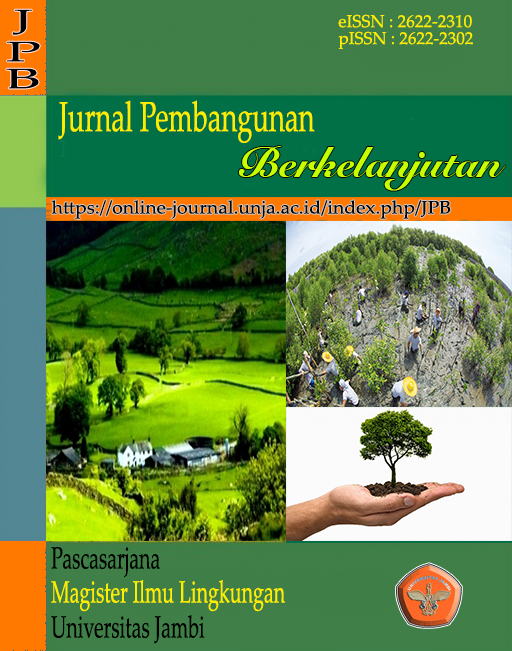Strategi Pengelolaan Sanitasi Lingkungan Dalam Penyelenggaraan Pelabuhan Sehat Di Pelabuhan Talang Duku Jambi
DOI:
https://doi.org/10.22437/jpb.v1i2.5399Keywords:
Strategy, Management, Environmental Sanitation, Healthy PortAbstract
The purpose of this research is to analyze the environmental sanitation management of port consisting of; Provision of clean water, food and beverage security, hygiene sanitation of building, pollution control, vector control and animal carriers of disease and formulate strategies for environmental sanitation management in the implementation of healthy ports at the Port of Talang Duku Jambi. This research was conducted in perimeter area and buffer area of ​​Talang Duku Jambi Port which is about 10 km distance from Jambi City. This research was conducted for 5 (five) months, that is from June 2017 until October 2017. From the research result, it can be concluded that environmental sanitation management activities at Talang Duku Jambi Port have not complied with standard such as 42,85% of PAB facilities have high contamination risk, 53,84% % hygiene sanitation of buildings and buildings have not met health requirements, less than 50% sewerage and septic tanks that have not met the health requirements, ABJ Aedes spp free rate of 69.23% and resting rate (RR) of Aedes adult mosquito spp in the buffer zone of 0.094 means Talang Duku Jambi Port area is prone to high risk of DBD transmission. Environmental sanitation management strategies to achieve healthy port objectives of regulatory implementation and advocacy, human resource development, establishing communication forums, establishing operational procedures standard for environmental risk control, making poster appeals supported by local law, and implementing healthy living community movement in the environment Port.
Downloads
References
__________________(2014), Pedoman Pengendalian Kecoa, Jakarta
__________________(2015), Pedoman Pengendalian Tikus dan Mencit, Jakarta
Hunger, J.D dan T.l. Wheelen,.(2003). Manajemen strategis. Penerbit ANDI. Surabaya.
International Health Regulation/IHR (2005). Public Health Emergency of International Concern. Jenewa.
Keputusan Menteri Kesehatan RI Nomor.1098 / Menkes / SK / VII / 2003 tentang Persyaratan Hygiene Sanitasi Rumah Makan dan Restoran.
Kurniawati, R., Wati, D.M., dan Y. Ariyanto,.(2015). Analisis Sebaran Kasus Demam Berdarah Dengue (DBD) di Kabupaten Jember Tahun 2014. Artikel Hasil Penelitian Mahasiswa. Jember.
Peraturan Pemerintah Nomor 41 Tahun 1999 tentang Pengendalian Pencemaran Udara.
Peraturan Menteri Kesehatan RI Nomor. 44 / Menkes / PER / VIII / 2014 tentang Penyelenggaraan Pelabuhan dan Bandara Sehat.
Peraturan Menteri Kesehatan RI Nomor 32 Tahun 2017 tentang Standar Baku Mutu Kesehatan Lingkungan dan Persyaratan Kesehatan Air untuk Keperluan Higiene Sanitasi, Kolam Renang, Solus Per Aqua, dan Pemandian Umum.
Peraturan Menteri Kesehatan RI Nomor 50 Tahun 2017 tentang Standar Baku Mutu Kesehatan lingkungan dan Persyaratan Kesehatan untuk Vektor dan Binatang Pembawa Penyakit serta pengendaliannya.
Rangkuti, F,.(2013). Teknik membedah kasus bisnis, Analisis SWOT, cara perhitungan bobot, rating, dan OCAI. Penerbit PT. Gramedia Pustaka Utama. Jakarta.
Roose, A. (2008). Hubungan Sosidemografi dan Lingkungan dengan Kejadian Penyakit Demam Berdarah Dengue di Kecamatan Bukit Raya Kota Pekanbaru. Universitas Sumatera Utara. Medan.
Sarudji, D,. (2010). Kesehatan Lingkungan, Karya Putra Darwati, bandung.
Sri, R.P,. Irnawati, M,. dan N. Evi. (2012). Higiene dan Sanitasi Terminal Pelabuhan Roro Kota Dumai Tahun 2012, Jurnal Kesmas, Universitas Medan.
Sumantri. A,. (2010). Kesehatan Lingkungan, Kencana Prenada Media Group, Jakarta.
Sutrisno. (2008). Kajian Manajemen dalam Pelaksanaan Sanitasi Lingkungan di Pelabuhan Pontianak, Thesis UNDIP Semarang.
Wibawa, A,.(2008). Faktor penentu kontaminasi Bakteriologi pada makanan jajanan di Sekolah Dasar. Jurnal Kesehatan Masyarakat Nasional Vol 3(1) : 3-8.

Downloads
Published
Versions
- 2018-08-15 (1)
- 2018-08-15 (1)
How to Cite
Issue
Section
License
1. Authors retain copyright and grant the journal right of first publication with the work simultaneously licensed under a Creative Commons Attribution 4.0 International License that allows others to share the work with an acknowledgement of the work's authorship and initial publication in this journal.
2. Authors are able to enter into separate, additional contractual arrangements for the non-exclusive distribution of the journal's published version of the work (e.g., post it to an institutional repository or publish it in a book), with an acknowledgement of its initial publication in this journal.
3. Authors are permitted and encouraged to post their work online (e.g., in institutional repositories or on their website) prior to and during the submission process, as it can lead to productive exchanges, as well as earlier and greater citation of published work (The Effect of Open Access)










